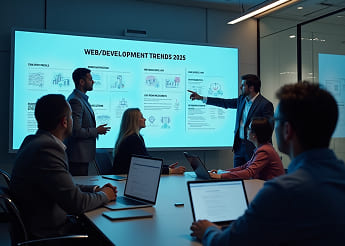
Top Web Development Trends to Watch in 2025
Web development is one of the fastest-evolving areas of technology, and staying ahead of trends is key to keeping your website relevant, engaging, and high-performing. As we move into 2025, businesses that embrace the latest technologies and user behaviors will create better digital experiences—and gain a serious edge.
Let’s explore the top web development trends expected to shape the web in 2025.


1. AI-Powered Experiences
Artificial intelligence is transforming how websites operate behind the scenes and on the front end. From predictive search and chatbots to personalized content and dynamic pricing, AI is now central to digital experiences.
Expect to see:
- AI chatbots with more human-like responses
- Smart recommendations based on browsing behavior
- AI-generated content for blogs or product descriptions
AI will become more integrated and invisible—working in the background to serve smarter, faster, and more relevant experiences.
2. Progressive Web Apps (PWAs)
PWAs offer the best of both web and mobile apps. They load fast, work offline, and can be installed on a user’s device—without going through an app store.
In 2025, more businesses will use PWAs to:
- Provide a mobile-app-like experience
- Improve engagement and retention
- Reduce development costs (one app for all platforms)
They’re especially valuable for startups and businesses that want to offer smooth mobile experiences without investing in separate iOS and Android apps.
3. Voice Search Optimization
With the rise of smart assistants and voice-activated devices, websites must adapt to voice search. This changes how people phrase queries and how content should be structured.
Voice-ready websites in 2025 will:
- Use natural, conversational language
- Optimize for featured snippets
- Focus on local and question-based queries
Businesses that plan content for voice search will be more discoverable and accessible.
4. Dark Mode as Default
Dark mode isn’t just a visual trend—it’s easier on the eyes, saves battery life, and is often preferred by users. Many users now expect websites and apps to offer a dark mode toggle by default.
In 2025, we’ll see more:
- System-responsive themes (auto-adjusting to device settings)
- Design systems that support both light and dark without breaking UI
- UX tests to optimize readability and contrast in dark interfaces
5. Enhanced Web Accessibility
Inclusivity is no longer optional. Accessibility is becoming a core design principle—and even a legal requirement in many countries.
Modern websites will:
- Offer screen-reader-friendly navigation
- Use proper color contrast, font sizes, and semantic HTML
- Include alt text, keyboard navigation, and ARIA labels
In 2025, businesses that fail to consider accessibility will not only lose customers but risk penalties.
6. API-First Development
The shift toward headless CMS and modular backends is pushing API-first development forward. This approach separates front-end and back-end logic, making development faster and more flexible.
With API-first architecture, businesses can:
- Build faster digital products across devices
- Create seamless integrations with third-party tools
- Launch updates or redesigns without rebuilding the backend
It also supports omnichannel strategies—reusing the same content for mobile apps, websites, IoT, and more.
In Summary
Web development in 2025 is about speed, personalization, and usability. The best websites will be those that feel smart, work everywhere, and respect user preferences. From AI and voice search to accessibility and design systems—these trends are shaping the new standard of the web.
If your site is stuck in the past, now’s the time to evolve.
